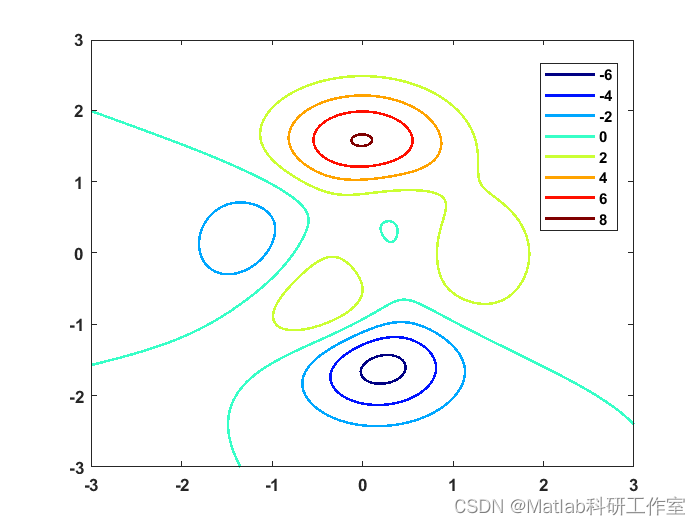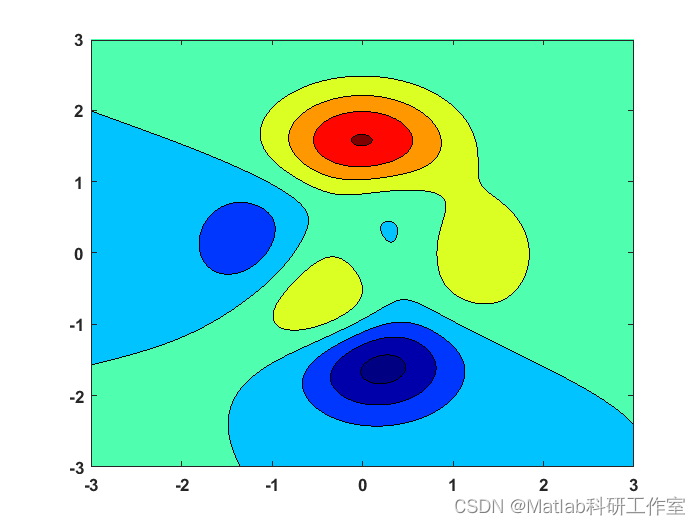1 内容介绍
MATLAB提供函数contour()绘制等高线图,函数contourf()绘制经过填充的等高线图,具体调用格式如下:
★ contour(z):该函数绘制矩阵z的等高线。
★ contour(x,y,z):该函数在指定坐标(x,y)下,画出矩阵 z 的等高线。
★ contour(z,n):该函数绘制n条等高线。
★ contour(x,y,z,[v v]):该函数绘制高度为 v 的等高线。
2 完整代码
close all
[X, Y, Z] = peaks(512);
figure
[~, hCont] = contour(X, Y, Z, ‘LineWidth’, 1.5);
contourLegend(hCont)
figure
[~, hCont] = contourf(X, Y, Z);
function [hLeg, levMat] = contourLegend(hCont, txtCont, locLeg, hOther, …
txtOther, posOther)
% [hLeg, levMat] = contourLegend(hCont, txtCont, locLeg, hOther, txtOther, …
% posOther)
% Adds a curve description legend to a contour plot. The default description is
% the level, but you may optionally supply custom descriptions. You might also
% include descriptions of other plotted objects in the legend.
%
% INPUT:
% hCont – a handle, or a vector of handles, to contour object(s) in the same
% plot.
% txtCont – an optional cell vector with strings that describes the curves,
% should have as many items as levels (“type” = ‘curves’) and fill
% intervals (“type” = ‘filled’). Default descriptions are the curve
% levels and fill intervals. Use the function with the “locLeg”
% option ‘notdrawn’ to get the current levels and fill intervals from
% “levMat”.
% locLeg – an optional string with the location of the legend. For available
% options see help for “legend”. Also supported is ‘notdrawn’ that
% will not add a legend. Default is ‘best’.
% hOther – an optional handle, or a vector of handles, to other graphics
% objects in the plot that you want to include in the legend.
% Default is empty.
% txtOther – an optional cell vector with strings that describes the other
% items above. Must be supplied if “hOther” is given and have as
% many items as the length of “hOther”. Default is empty.
% posOther – an optional string ‘b(efore)’ or ‘a(fter)’ that determines if the
% description of other graphic objects comes before or after the
% descriptions of the contours in the legend. Default is ‘after’.
%
% OUTPUT:
% hLeg – a handle to the legend object. Use this to change the position,
% fonts etc. for the legend.
% levMat – a two column matrix with the contour levels limits in each row.
% Equal limits indicate a contour curve and unequal a filled area.
%
% NOTE 1: The colors for the contours in the legend will NOT be updated if they
% are changed in the plot, for example by changing the color map. It is
% recommended that the legend is added after all plotting is done.
% NOTE 2: There is a strange bug, at least in R2020a. The contour levels
% shown in the tooltip, if you click on a contour curve, will not the
% match the levels in the legend (and the ones returned in the contour
% data matrix).
%
% EXAMPLE:
% [X, Y, Z] = peaks(512);
% figure
% [~, hCont] = contour(X, Y, Z, ‘LineWidth’, 1.5);
% contourLegend(hCont)
% figure
% [~, hCont] = contourf(X, Y, Z);
% contourLegend(hCont)
%
% See also contour, contourf, clabel, legend
%
% Version 1.1, 2022. Patrik Forssén, Karlstad University.
% Version History
% Version 1.1: Remove type and used hidden property instead
% Default input
if (nargin < 2), txtCont = []; end
if (nargin < 3 || isempty(locLeg)) , locLeg = ‘best’ ; end
if (nargin < 4), hOther = []; end
if (nargin < 5), txtOther = []; end
if (nargin < 6 || isempty(posOther)), posOther = ‘after’; end
% Default output
hLeg = [];
% Check input
hCont = hCont(:);
hOther = hOther(:);
[hAx, locLeg, hOther, txtOther, posOther] = checkInput(…
hCont, txtCont, locLeg, hOther, txtOther, posOther);
% Get contour curve specification
curveSpec = contourCurves(hCont);
% Set ‘flat’ to a color specification
curveSpec = flat2color(hAx, curveSpec);
% Get handles to curve specification invisible dummy lines or patches
[hCurve, txtCurve, levMat] = getCurveHandles(hAx, curveSpec, txtCont);
% Draw legend
if (~strcmp(locLeg, ‘notdrawn’))
hLeg = drawLeg(hAx, locLeg, hCurve, txtCurve, hOther, txtOther, posOther);
end
% Output
if (nargout == 0)
clear hLeg
end
end
function hLeg = drawLeg(hAx, locLeg, hCurve, txtCurve, hOther, txtOther, …
posOther)
hItem = hCurve;
txtItem = txtCurve;
if (~isempty(hOther))
% Add
switch posOther
case ‘before’
hItem = [hOther ; hItem];
txtItem = [txtOther; txtItem];
case ‘after’
hItem = [hItem ; hOther];
txtItem = [txtItem; txtOther];
end
end
% Draw the legend
hLeg = legend(hAx, hItem, txtItem, ‘Location’, locLeg);
end
function [hCurve, txtCurve, levMat] = getCurveHandles(hAx, curveSpec, …
txtCont)
% Function name
funName = mfilename;
% Number of curves
nCurves = size(curveSpec, 1);
% Unique levels
unLev = unique(cell2mat(curveSpec(:, 1)));
levMat = [];
for curveNo = 1 : nCurves
currLev = curveSpec{curveNo, 1};
currType = curveSpec{curveNo, 5};
switch currType
case ‘curves’
levMat = [levMat; currLev, currLev];
case ‘filled’
currLevInd = find(unLev == currLev, 1, ‘first’);
if (currLevInd == length(unLev))
levMat = [levMat; currLev, inf];
else
levMat = [levMat; currLev, unLev(currLevInd+1)];
end
end
end
levMat = unique(levMat, ‘rows’);
levMat = sortrows(levMat, [1 2]);
% Make a default text cell
unLevCell = cell(size(levMat, 1), 1);
for levNo = 1 : size(levMat, 1)
currInt = levMat(levNo, :);
if (currInt(1) == currInt(2))
unLevCell{levNo} = num2str(currInt(1));
else
if (~isfinite(currInt(2)))
unLevCell{levNo} = [‘> ‘, num2str(currInt(1))];
else
unLevCell{levNo} = [num2str(currInt(1)), ‘ to ‘, num2str(currInt(2))];
end
end
end
% Check legTxt if supplied
nUn = size(levMat, 1);
if (~isempty(txtCont))
if (length(txtCont) > nUn)
warnStr = [‘Input 3, “txtCont”, contains to many strings (should ‘, …
‘contain ‘, num2str(nUn), ‘). Extra entries will be ignored’];
warning([funName, ‘:TooManyStrings’], warnStr)
txtCont = txtCont(1:nUn);
elseif (length(txtCont) < nUn)
warnStr = [‘Input 3, “txtCont”, contains too few strings (should ‘, …
‘contain ‘, num2str(nUn), ‘). Will use default for missing items’];
warning([funName, ‘:TooFewStrings’], warnStr)
txtCont(end+1:nUn) = unLevCell(length(txtCont)+1:end);
end
else
% Default
txtCont = unLevCell;
end
% Plot dummy lines/patches
hold(hAx, ‘on’);
txtCurve = cell(nCurves, 1);
hCurve = gobjects(nCurves, 1);
nanVec = [NaN, NaN, NaN, NaN];
for curveNo = 1 : nCurves
currCurve = curveSpec(curveNo, :);
currLev = currCurve{1};
switch currCurve{5}
case ‘curves’
levInd = find(levMat(:, 1) == currLev & levMat(:, 2) == currLev, …
1, ‘first’);
hCurve(curveNo) = plot(hAx, NaN, ‘LineStyle’, currCurve{2}, …
‘LineWidth’, currCurve{3}, ‘Color’, currCurve{4});
case ‘filled’
levInd = find(levMat(:, 1) == currLev & levMat(:, 2) > currLev, …
1, ‘first’);
hCurve(curveNo) = patch(hAx, nanVec, nanVec, currCurve{4});
end
txtCurve{curveNo} = txtCont{levInd};
end
end
function curveSpec = flat2color(hAx, curveSpec)
% Unique levels
unLev = unique(cell2mat(curveSpec(:, 1)));
% Get color mapping
colMap = hAx.Colormap;
nCol = size(colMap, 1);
colLim = hAx.CLim;
if (length(unLev) == 1)
% Special, uses the middle color
colNo = round(nCol/2);
else
% Linear interpolation
pp = polyfit(colLim, [1 nCol], 1);
colNo = round(polyval(pp, unLev));
end
% Possibly map to last and first color
colNo(unLev < colLim(1)) = 1;
colNo(unLev > colLim(end)) = nCol;
% Safeguard…
colNo(colNo < 1 ) = 1;
colNo(colNo > nCol) = nCol;
% Curves with ‘flat’
flatInd = find(cellfun(@ischar, curveSpec(:, 4)));
for flatNo = flatInd(:)’
levNo = find(curveSpec{flatNo, 1} == unLev, 1, ‘first’);
curveSpec{flatNo, 4} = colMap(colNo(levNo), :);
end
% Only want unique rows
curveSpec = uniqueCellRows(curveSpec);
end
function curveSpec = contourCurves(hCont)
% Must be called…
drawnow
% Column 1 : level
% Column 2 : LineStyle
% Column 3 : LineWidth
% Column 4 : LineColor (‘flat’ or RGB triplet)
% Column 5 : type
curveSpec = cell(0, 5);
for objNo = 1 : length(hCont)
currObj = hCont(objNo);
lineStyle = currObj.LineStyle;
lineWidth = currObj.LineWidth;
if (~isempty(currObj.FacePrims))
% Undocumented!
type = ‘filled’;
lineColor = ‘flat’;
else
type = ‘curves’;
lineColor = currObj.LineColor;
end
levVec = currObj.LevelList;
for levNo = 1 : length(levVec)
currLev = levVec(levNo);
cellRow = {currLev, lineStyle, lineWidth, lineColor, type};
curveSpec = [curveSpec; cellRow];
end
end
% Only want unique rows
curveSpec = uniqueCellRows(curveSpec);
end
function [CU, keepInd, rmMap] = uniqueCellRows(C)
% Get unique cell rows
nRows = size(C, 1);
rmMap = 1 : nRows;
rmInd = [];
for refNo = 1 : nRows
if (ismember(refNo, rmInd)), continue, end
refRow = C(refNo, :);
for compNo = refNo+1 : nRows
if (ismember(compNo, rmInd)), continue, end
compRow = C(compNo, :);
if (isequal(refRow, compRow))
rmInd = [rmInd; compNo];
rmMap(compNo) = refNo;
end
end
end
% Trim
keepInd = setdiff(1:nRows, rmInd);
CU = C(keepInd, :);
end
%——————————–CHECK INPUT————————————
function [hAx, locLeg, hOther, txtOther, posOther] = checkInput(…
hCont, txtCont, locLeg, hOther, txtOther, posOther)
% Function name
funName = mfilename;
% 1: hCont
errStr = [‘Input 1, “hCont”, should be graphic handle(s) to ‘, …
‘contour objects in the same plot’];
if (any(~ishandle(hCont)))
error([funName, ‘:WrongInput’], errStr)
end
iscontour = @(h) isgraphics(h, ‘contour’);
if (any(~iscontour(hCont)))
error([funName, ‘:WrongInput’], errStr)
end
[res, hAx] = checkSameAxes(hCont);
if (~res)
error([funName, ‘:WrongInput’], errStr)
end
% 2: txtCont
if (~isempty(txtCont))
if (ischar(txtCont)), txtCont = {txtCont}; end
txtCont = txtCont(:);
errStr = ‘Input 2, “txtCont”, should be a cell array with strings’;
tFun = @(x) ischar(x) & isvector(x);
if (any(~cellfun(tFun, txtCont)))
error([funName, ‘:WrongInput’], errStr)
end
end
% 3: locLeg
validStr = {…
‘north’
‘south’
‘east’
‘west’
‘northeast’
‘northwest’
‘southeast’
‘southwest’
‘northoutside’
‘southoutside’
‘eastoutside’
‘westoutside’
‘northeastoutside’
‘northwestoutside’
‘southeastoutside’
‘southwestoutside’
‘best’
‘bestoutside’
‘none’
‘notdrawn’};
errStr = ‘Input 3, “locLeg”, should be a valid legend position string’;
if (~ischar(locLeg) && ~isvector(locLeg))
error([funName, ‘:WrongInput’], errStr)
end
locLeg = validatestring(locLeg, validStr, funName, ‘locLeg’, 3);
% 4: hOther
if (~isempty(hOther))
errStr = [‘Input 4, “hOther”, should be graphic handle(s) to ‘, …
‘objects in the same plot as the contours’];
if (any(~ishandle(hOther)))
error([funName, ‘:WrongInput’], errStr)
end
if (~checkSameAxes(hOther, hAx))
error([funName, ‘:WrongInput’], errStr)
end
% 5: txtOther
if (ischar(txtOther)), txtOther = {txtOther}; end
txtOther = txtOther(:);
errStr = ‘Input 5, “txtOther”, should be a cell array with strings’;
tFun = @(x) ischar(x) & isvector(x);
if (any(~cellfun(tFun, txtOther)))
error([funName, ‘:WrongInput’], errStr)
end
if (length(txtOther) > length(hOther))
warnStr = [‘Input 5, “txtOther”, contains to many strings (should ‘, …
‘contain ‘, num2str(length(hOther)), ‘). Extra entries will be ignored’];
warning([funName, ‘:TooManyStrings’], warnStr)
txtOther = txtOther(1:length(hOther));
elseif (length(txtOther) < length(hOther))
warnStr = [‘Input 5, “txtOther”, contains too few strings (should ‘, …
‘contain ‘, num2str(length(hOther)), ‘). Missing items will be ignored’];
warning([funName, ‘:TooFewStrings’], warnStr)
hOther = hOther(1:length(txtOther));
end
% 6: posOther
validStr = {‘before’, ‘after’};
errStr = ‘Input 6, “posOther”, should be string ”before” or ”after”’;
if (~ischar(posOther) && ~isvector(posOther))
error([funName, ‘:WrongInput’], errStr)
end
posOther = validatestring(posOther, validStr, funName, ‘posOther’, 6);
end
end
function [res, hAx] = checkSameAxes(hVec, hAx)
% Checks if graphic objects belong to the same axes
% Default input
if (nargin < 2), hAx = []; end % Reference axes
hVec = hVec(:);
axesVec = gobjects(1, length(hVec)+length(hAx));
for objNo = 1 : length(hVec)
currObj = hVec(objNo);
while (1)
parent = currObj.Parent;
if (strcmp(parent.Type, ‘axes’))
axesVec(objNo) = parent;
break
elseif (strcmp(parent.Type, ‘root’))
% All the way up to the root
res = false;
return
end
currObj = parent;
end
end
if (isempty(axesVec)) , return, end
if (~isempty(hAx)), axesVec(end) = hAx; end
% Check if all axes are the same
res = true;
refAx = axesVec(1);
for axNo = 2 : length(axesVec)
currAx = axesVec(axNo);
if (~isequal(refAx, currAx))
res = false;
return
end
end
% Set output
hAx = axesVec(1);
end
3 运行结果
4 参考文献
博主简介:擅长智能优化算法、神经网络预测、信号处理、元胞自动机、图像处理、路径规划、无人机、雷达通信、无线传感器等多种领域的Matlab仿真,相关matlab代码问题可私信交流。
部分理论引用网络文献,若有侵权联系博主删除。
今天的文章【基础教程】Matlab实现等高线图分享到此就结束了,感谢您的阅读。
版权声明:本文内容由互联网用户自发贡献,该文观点仅代表作者本人。本站仅提供信息存储空间服务,不拥有所有权,不承担相关法律责任。如发现本站有涉嫌侵权/违法违规的内容, 请发送邮件至 举报,一经查实,本站将立刻删除。
如需转载请保留出处:https://bianchenghao.cn/8451.html


